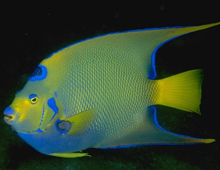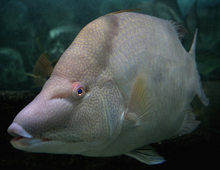Caribbean Creatures

Blue parrotfish, Scarus coeruleus
Parrotfish are named for their brilliant colors and their beaks, formed by many teeth fused together in a mosaic. Once classified in their own family, the 90 or so species are now considered highly specialized wrasses. They are a vital component of the ecology of coral reefs, pulverizing coral to extract algae and producing vast amounts of sand. Of the fourteen species found off North America, the Blue parrotfish, found widely in the Caribbean, is one of the most recognizable, adult males being solidly blue. Almost all parrotfish begin life as females.
LEARN MORE
Lookdown fish, Selene vomer
Reaching a length of a foot-and-a half and weighing less than five pounds, this is one of the smaller members of the Jack family, which includes such well-known game fishes as the Amberjack, as well as the Yellowtail featured in Sushi bars. Despite its small size, it is considered delicious, like its relative the Pompano. It is found in large schools in the Tropical Atlantic and the Gulf of Mexico and is common along the Texas coast. The peculiar head structure which gives it its name, has made it popular as a public aquarium animal for many years.
LEARN MORE
French angelfish, Pomacanthus paru
Easily growing over a foot in length, this is one of the most popular fishes with divers in the Bahamas, Florida, and other places in the Tropical Atlantic. It is a typical sight in Texas’ Flower Garden Banks sanctuary. While adults are black with golden edging to their scales, juveniles have a pattern of broad yellow bands, which serve a “Barber’s Pole” purpose, since young French angels are “cleaners” of much larger fishes that do not harm them. Adults eat mostly sponges. This has been a favorite aquarium exhibit for more than a century.
LEARN MORE
Queen angelfish, Holocanthus ciliaris
One of the first salt water tropical fishes to be kept in aquariums, this beautiful fish was exhibited live by P.T. Barnum (of circus fame) at his American Museum in New York in the 1860s and has remained a popular species in public aquariums ever since. In the 1930s, the New York Aquarium sent specimens all the way by ship to East London, in South Africa, in exchange for turkeyfish. In parts of its extensive range in the Caribbean, the Gulf of Mexico, and the Tropical Western Atlantic, it is a food fish. Its wild diet is almost exclusively sponges.
LEARN MORE
Rooster hogfish, Lachnolaimus maximus
Though dwarfed by its six-foot long, 300-pound Pacific relative, the Napoleon wrasse, at nearly three feet, and over 20 pounds, the hogfish is the largest wrasse in the Caribbean. Like the Napoleon Wrasse, it is threatened by overfishing. Considered delicious, it is a prime target for spear fisherman. It is classified as Vulnerable to Extinction over its range from Bermuda to Brazil. It remains abundant in some habitats, such as the Florida Keys. Its powerful jaws and teeth equip it to consume crabs, sea urchins and mollusks.
LEARN MORE
Spotted eagle ray, Aetobatus narinari
The Spotted eagle ray is named for the spots on the dorsal side of its body, and for the way that it appears to “fly” underwater. It is also known as a Duckbill ray because of the unique shape of its nose which is used to locate its prey in sandy sediments. Spotted eagle rays can be found in large schools in bays or coral reefs, but spend a great deal of time in open water. When being pursued by a potential predator, it can be seen leaping from the water. The Spotted eagle ray possesses a venomous spine at the base of its tail and can inflict a serious wound. It is protected by law in the State of Florida, but is not considered an important commercial fisheries species.
LEARN MORE

